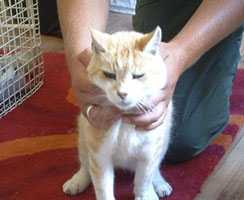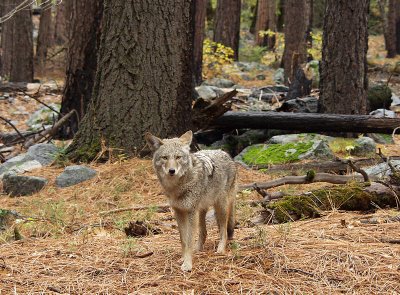A Collar Saves Turbo from Extermination after He Is Illegally Trapped by Bird-Loving Psychopaths

"I cannot agree that it should be the declared public policy of Illinois that a cat visiting a neighbor's yard or crossing the highways is a public nuisance. It is in the nature of cats to do a certain amount of unescorted roaming. Many live with their owners in apartments or other restricted premises, and I doubt if we want to make their every brief foray an opportunity for a small game hunt by zealous citizens -- with traps or otherwise.
"I am afraid this bill could only create discord, recrimination and enmity. Also consider the owner's dilemma: to escort a cat abroad on a leash is against the nature of the cat, and to permit it to venture forth for exercise unattended into a night of new dangers is against the nature of the owner. Moreover, cats perform useful service, particularly in rural areas, in combating rodents -- work they necessarily perform alone and without regard for property lines.
"We are all interested in protecting certain varieties of birds. That cats destroy some birds, I well know, but I believe this legislation would further but little the worthy cause to which its proponents give such unselfish effort. The problem of cat versus bird is as old as time. If we attempt to resolve it by legislation who knows but what we may be called upon to take sides as well in the age old problems of dog versus cat, bird versus bird, or even bird versus worm. In my opinion, the State of Illinois and its local governing bodies already have enough to do without trying to control feline delinquency."
-- Adlai E. Stevenson, Cat Bill Veto, April 23, 1949
Debbie and Robert McCallum of the Seattle suburb of Edmonds hate cats with a passion. So, when Laura Martin's two-year-old adopted stray, Turbo (See photos above and below), wandered into their yard on September 13th they were ready for him.
After successfully luring him into a wire trap baited with cat food, they held him hostage overnight in their garage and in the morning handed him over to animal control. Turbo was taken to Adix's Bed and Bath animal shelter where he was subsequently reunited with Martin because he luckily was wearing a collar identifying her as his owner. Had it not been for his collar, Turbo likely would have been exterminated.
As it was, he cut his face in several places trying to extricate himself from the trap and a subsequent trip to the vet cost his owner $58.25. "He was cut to the bone on one side of his cheek," Martin later told The Herald of Everett. (See "Cat Trapping Leads to Spat.")
Martin is now demanding that the McCallums not only ante up for Turbo's veterinary bill but that they also be prosecuted under a Washington State law that makes it a gross misdemeanor to either take or confine a pet.
Predictably, the McCallums are bird-lovers. They raise quail although it is unclear if this is done as a hobby or a commercial venture. Whatever the case, they allege that Turbo is not only guilty of killing their birds but also of fouling their property with feces and urine.
"Cats belonging to two neighbor families use my yard for their personal latrine; they spray on my door," Debbie complained to The Seattle Times on October 11th. (See "Fur Flies in Neighborhood After Trapping of Errant Cat.")
When Turbo did not come home as expected, Martin spent several frantic hours searching for him in vain. "I was crying, I was hysterical," she told The Seattle Times. "I was out searching for him in the rain and dark with a flashlight," she amplified on her distress for The Herald.

Being not only inveterate cat-haters but sadistic and vindictive to boot, the McCallums ignored her cries. "I heard them whistling for him that night," Debbie later confessed to The Seattle Times. "I felt bad. But I wanted to prove a point: keep their cats at home, on their own property and this won't happen."
In Washington as elsewhere, the laws regarding wandering cats are rather convoluted. Although some cities prohibit them from roaming, Edmonds is not one of them. Furthermore, city law requires three complaints from three separate residences before a cat can be declared to be nuisance and legally trapped.
More to the point, killing wild birds is not considered to be a nuisance because they do not normally belong to anybody; hand-raised quail could enjoy an altogether different legal status, however. Nonetheless, it is perfectly clear that the trapping of Turbo was patently illegal.
As the country becomes more and more crowded confrontations between cat-owners and cat-haters are becoming more common. For instance, bird-lover Richard DeSantis of West Islip, Long Island has made a career of trapping his neighbors' cats and then turning them over to the local shelter to exterminate. (See Cat Defender post of June 15, 2006 entitled "Serial Cat Killer on Long Island Traps Neighbors' Cats and Then Gives Them to Shelter to Exterminate.")
Lacking DeSantis' guile, Charlottesville used car dealer George Seymour put a rifle bullet through the neck of his next-door neighbor's cat because he allegedly spotted her on top of one of his cars. (See Cat Defender post of June 22, 2006 entitled "Used Car Dealer in Virginia Murders Sweet Three-Year-Old Cat Named Carmen with Rifle Shot to the Neck.")
The escalating number of these disputes has led many municipalities to enact anti-roaming statutes, leash laws, and cat licensing requirements. This is not really anything new. Bird advocates have sponsored anti-cat legislation before but politicians used to have enough gumption and intelligence to say no to these evil individuals and groups.
For instance, on April 23, 1949 Illinois Governor Adlai E. Stevenson vetoed a law that would have restrained cats. "I cannot agree that it should be the declared public policy of Illinois that a cat visiting a neighbor's yard or crossing the highways is a public nuisance. It is in the nature of cats to do a certain amount of unescorted roaming. Many live with their owners in apartments or other restricted premises, and I doubt if we want to make their every brief foray an opportunity for a small game hunt by zealous citizens -- with traps or otherwise," he sagely reasoned.
"I am afraid this bill could only create discord, recrimination and enmity," he continued. "Also consider the owner's dilemma: to escort a cat abroad on a leash is against the nature of the cat, and to permit it to venture forth for exercise unattended into a night of new dangers is against the nature of the owner. Moreover, cats perform useful service, particularly in rural areas, in combating rodents -- work they necessarily perform alone and without regard for property lines.
"We are all interested in protecting certain varieties of birds. That cats destroy some birds, I well know, but I believe this legislation would further but little the worthy cause to which its proponents give such unselfish effort. The problem of cat versus bird is as old as time. If we attempt to resolve it by legislation who knows but what we may be called upon to take sides as well in the age old problems of dog versus cat, bird versus bird, or even bird versus worm. In my opinion, the State of Illinois and its local governing bodies already have enough to do without trying to control feline delinquency," he concluded.
The McCallums, DeSantis, and Seymour are psychopaths. Not only are they bereft of an ounce of respect for either cats or their owners, but they have little or no regard for the law as well. They should accordingly be removed from civil society and locked away in cages.
It is also important to remember that birds are far from being model citizens of this planet. They destroy crops, set forest fires, spread diseases, and foul yards, streets, and streams with their feces and urine. Despite all of this, no one has ever accused a cat-lover of trapping and exterminating birds.
In addition to being psychopaths, bird-lovers are also hypocrites. They never go ballistic when deer, mice, squirrels, chipmunks, raccoons, and other animals trespass onto their turf. Nor do they ever seem to have much to say about air and noise pollution from automobiles, airplanes, factories, and their neighbors' houses wafting into their yards. In fact, some studies have found that noise pollution impedes the ability of songbirds to teach their offsprings to sing. Despite all of this, it is only the sight of a cat that brings out the homicidal urges in bird-lovers.

No mentally balanced person behaves in such a manner. Any halfway rational person knows that unwanted felines can be easily deterred through the judicious use of nonviolent water, scent, and noise repellents. Bird feeders can also be relocated to the tops of tall poles.
The sad truth of the matter is that this society is chock-full of cat-haters who are not the least bit hesitant about taking the law into their own hands and killing cats. It is therefore incumbent upon all cat owners to be constantly on the lookout for these monsters and to take measures to ensure the well-being of their cats.
Cats deserve time outdoors but they need to be under supervision. Fenced-in yards and patios are ideas worth exploring as well as training a cat to walk on a leash. Should worse come to worse, cat owners would be well advised to sell out and move if they discover that bird-lovers are living in the neighborhood. These psychopaths are not only dangerous but unpredictable as well.
Finally, the fact that there are people in this world who purposefully trap cats just so that they can give them to shelters to exterminate is another good reason that both shelters and pet genocide should be outlawed. Moreover, shelters are so derelict in their duties that they do not even require proof that a person surrendering a cat is in fact the cat's lawful owner! It is truly amazing that shelters have not been subjected to a torrent of wrongful death lawsuits.
Some shelters, such as the one in Hollister, California, even have the chutzpah to charge pet owners a fee in order to reclaim cats and dogs that were illegally trapped and surrendered. That was the situation that Brandie Locke found herself in when her beagle, Lady (See photo above), unexpectedly turned up at the shelter. (See The Pinnacle, October 27, 2006, "Property Owners Vs. Pet Owners.")
As was the case with Turbo, Lady was wearing tags and as the result she was soon reunited with her owner. Sadly, thousands of cats and dogs are not nearly so lucky.
Photos: John Lok of The Seattle Times (Laura Martin and Turbo), Jennifer Buchanan of The Herald (Martin and Turbo), and Danielle Stolman of The Pinnacle (Brandie Locke and Lady).






























